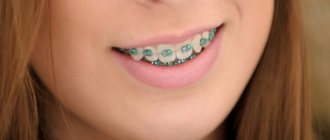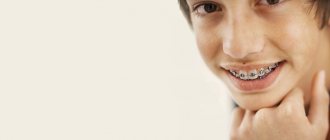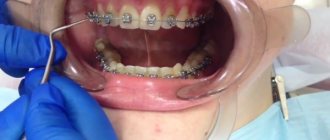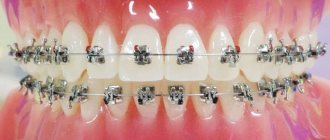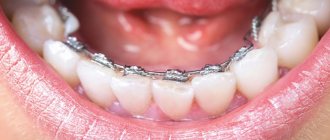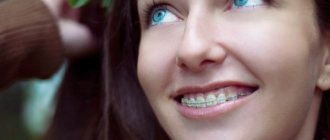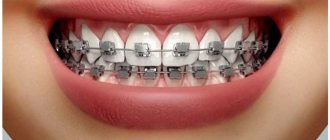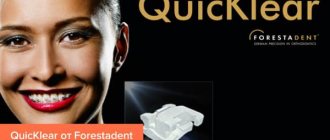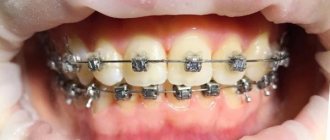How do braces work?
A standard braces system consists of 3 main components:
- braces (special plates that are glued to the teeth),
- metal arc (with its help the braces are connected to each other),
- mechanism for fixing the arch in the bracket groove (using ligatures or locking fasteners).
Braces work by applying constant, slight pressure to the teeth. The pressure is created by a metal wire that passes through each bracket and connects them to each other. During the treatment process, the orthodontist will use metal arches of different shapes and thicknesses, and will loosen or tighten the ligatures - all this allows you to change the degree of pressure on the teeth, achieving their desired position.
It must be said that not only the teeth themselves experience pressure, but most importantly, the bone tissue around them. Under the pressure experienced in the bone tissue, the processes of bone remodeling are launched (parallel resorption of the bone in the direction of tooth movement, and its formation behind the direction of tooth movement). This process is very slow and therefore the treatment takes a long time.
What examinations need to be completed before installation?
If you definitely decide to become the owner of a Hollywood smile, before starting orthodontic treatment you will have to undergo a preliminary diagnosis, which includes an initial examination of the oral cavity and drawing up a photo protocol. Then impressions are taken, from which a plaster model is made - a copy of the patient’s teeth, necessary for making accurate calculations. The doctor measures the size of the teeth and determines in which plane a particular patient has a deficiency or, conversely, a surplus of space. Computer diagnostics are required; a lateral view of the head is taken, which allows one to see the true size of the jaws and their position in relation to the facial skeleton.
“We need to understand that when we examine patients, there are always soft tissues, there are muscles that can camouflage the pathology. This lateral projection image allows us to fully identify the problem and choose the appropriate treatment tactics,” noted Evgenia Belousova.
Also, in some cases, a CT scan is required. Such an in-depth examination is necessary if the orthodontist has doubts about the health or configuration of the roots of the teeth. In addition, CT allows you to see unerupted teeth or thin biotype, that is, thin bone tissue, which is extremely important because when teeth move, they must remain within the bone.
Thus, a standard examination includes photographs, casts, computer examination and drawing up a photo protocol.
Preparation
Before installing braces, you need to do three things: put fillings, take a panoramic photo of the jaw and remove teeth as prescribed by the orthodontist.
Fillings can be placed in any clinic, regardless of where your orthodontist sees you. You can treat your teeth before visiting the orthodontist; in any case, this will have to be done before installing braces. If dental care is included in your work health insurance, get it covered.
You will need an image of the jaw - also known as an orthopantomogram - in any case. It is convenient to do it in advance, before you go to the orthodontist. The photo costs about one and a half thousand rubles, it can also be done in any clinic. An orthopantomogram is usually not included in insurance.
When to and when not to wear braces
Leveling systems make it possible to solve dental problems such as:
curvatures caused by improper eruption of permanent elements;- displacement of “neighbors” after removal of the affected unit;
- congenital disorders in the development of the upper or lower jaw.
The devices perfectly cope with crowding and large interdental gaps. But not everyone can install them.
Contraindications include:
- oncology;
- epilepsy;
- mental illness;
- bruxism;
- allergy to the material from which the device is made;
- serious pathologies of the bone tissue of the jaw;
- blood diseases;
- tuberculosis;
- diseases of the endocrine and immune systems.
It is also important that the patient first cures all existing dental diseases and undergoes professional oral hygiene. The teeth and gums must be completely healthy by the time the braces are fixed.
Types of braces –
All types of braces can be classified according to several parameters, for example, by type of material and design features. We will discuss their pros and cons of each type in detail below.
Bracket system: types (table 1)
| By material type: | By type of construction: |
| Metal | Vestibular |
| Ceramic | Lingual |
| Ceramic with metal groove and/or lock | Ligature |
| Sapphire | Unligated (self-ligating) |
Braces: photo
In the photo you can see different types of braces listed in Table 1
Treatment with partial braces: the most important steps
Before installing partial braces, the patient undergoes several important procedures, thanks to which the orthodontist will be able to see and assess how badly the relationship of the dentition is affected. These procedures include:
- Patient examination (preliminary)
- Diagnosis using manual methods
- Establishing a diagnosis
- Taking an impression of the jaw
- Research by cephalometric method
- Assessing the complexity of the pathology and choosing the optimal design that will suit the patient, both in terms of correction and financial capabilities.
Once all of the above procedures have been completed, the process of creating the design and installing braces will begin.
How much does it cost to install braces?
How much does it cost to get braces on your teeth? The price range is quite wide. Prices for full treatment:
- Initial consultation and diagnosis of diseases and disorders. Depending on the level of the clinic and the availability of high-quality equipment, the stage will cost from 1000 to 4000 rubles.
- Preliminary preparation. For the treatment of caries of 1 tooth, a patient will spend from 1,500 to 20 thousand rubles. Treatment of 1 root canal ranges from 1000 to 30 thousand rubles. Treatment of gums in the area of 1 tooth will cost from 400 rubles to 20 thousand rubles.
- Prices for metal braces vary from 10 to 130 thousand rubles. Sapphire designs have a high cost - from 20 to 270 thousand rubles. The price of ceramic braces ranges from 16 to 240 thousand rubles. If a patient wants to install plastic staples, he will need from 8 to 80 thousand rubles.
The cost of non-ligature structures ranges from 15 thousand to 300 thousand rubles. Lingual braces will cost 24-300 thousand rubles.
Prices vary depending on the prestige of the clinic, the availability of special equipment, materials, and the level of work of specialists.
So, you have cured your teeth, taken a picture, chosen an orthodontist and removed any extra teeth, if any.
After this, an impression of your teeth will be made. Using it, the doctor models a treatment regimen. A cast costs 2.5-3 thousand rubles. At the end of treatment, the impression is usually returned to the patient as a keepsake.
My cast: left as a keepsake
After this, you will be given a date for installing braces. Braces are the main expense when straightening teeth.
You will need to install two braces: for the upper and lower jaw. A single bracket system is not installed: it is believed that treatment should be comprehensive and correct the entire bite. Therefore, it will not be possible to correct curvature, for example, only in the lower jaw.
At first, braces will be placed on only one jaw, usually the upper jaw. In a couple of months you will get used to the braces, and the doctor will look at your progress and how your teeth move. At this time, you will wear the thinnest archwire. After this, braces will be placed on the lower jaw.
The most common types of braces in Russia are metal, ceramic, sapphire and lingual.
Ceramic braces match the color of tooth enamel, so they are practically invisible on the teeth. But it is believed that they are less effective than metal ones - you will have to wear them longer. And they cost more. Another disadvantage: light ceramic ligatures are stained. Therefore, doctors recommend not drinking red wine, strong black tea, or eating beets if you wear ceramic braces. One arc of ceramic braces in 2020 cost me 40 thousand rubles.
Sapphire braces are made from artificial crystal, completely transparent, and expensive. One arc costs from 50 thousand rubles.
DETAILS: Threads in cosmetology what are they photo
Lingual braces are another type of braces system. This arch is installed on the back side of the teeth, so they are completely invisible to others. Lingual braces make your mouth smaller, so you may develop a lisp. Lingual braces are the most expensive option. One arc costs from 70 thousand rubles.
You can combine different types of braces: for example, put ceramic ones on the upper jaw, and iron ones on the lower jaw, which is less visible. I did so.
The photo was taken on the last day of wearing braces. Ceramic braces on the upper jaw, metal braces on the lower jaw
Different clinics pay differently. I know that some dentists ask you to pay for the entire complex treatment at once. I paid in stages, after each brace system was installed and after each visit to the orthodontist.
Equipment does not count
Braces are a device, not a treatment. You will not be given a tax deduction for their cost.
Cost of partial braces in Moscow dentistry
Teenagers receive orthodontic appliances in the same way as adults. However, the process of correcting the bite takes less time, since the hard tissues of adolescents are not yet fully formed. As a rule, doctors prefer self-ligating structures that do not require frequent visits to the orthodontist. Another priority choice is invisible sapphire systems, which help to avoid the appearance of complexes in a child.
Young children with primary teeth are not given braces, as this is dangerous for the oral cavity and especially for delicate enamel. The optimal age is after 14 years, in some cases – 10-12 years, but not earlier.
Teenagers are given braces in the same way as adults.
The appearance of braces depends on what materials they are made of and how they are installed. The most common options differ for the upper and lower jaws.
A bracket system that is attached to one jaw is called partial
For the lower jaw
If the upper jaw does not require orthodontic treatment, braces are installed only on the lower jaw. The following materials and designs are used:
- Metal is one of the most popular options. Their cost is low, and the lack of aesthetics is compensated by the fact that the systems are invisible when smiling, since the lower dentition is hidden by the lip. The products are safe and very effective due to the strength of the metal.
- Lingual systems are installed on the inside of the row, so they are invisible either during a conversation or in a photo.
- Sapphire designs are virtually invisible due to their ability to transmit light. This material is safe, does not cause allergies and does not injure the mucous membrane. However, such braces are quite expensive, so not all patients choose them as a way to correct the position of the lower jaw.
Partial braces on the lower jaw
If the upper jaw requires correction, specialists also select a suitable design from those listed above. Patients consider lingual braces to be the best option, as they have a number of advantages:
- When communicating, they are invisible, since they are attached to the inside of the row.
- Quick results in a relatively short period of time.
- Injury is excluded, since there is no contact of the system elements with the lips and cheeks.
Ceramic braces for the upper jaw
To correct the dentition, the dentist can offer two types of metal braces, which have different attachment points:
- Vestibular.
This type of braces is installed on the outer surface of the crowns, facing the lips. Despite the fact that most manufacturers are constantly working to improve system elements, making them less noticeable, the design is still not very aesthetically pleasing. Even the tiniest models are visible when talking and smiling. - Lingual.
The elements of this design are fixed on the inner side of the teeth, facing the tongue. This installation allows you to correct your bite without anyone noticing. Unlike the first option, this system has a long period of adaptation and is capable of influencing diction.
The minimum cost of a vestibular structure with installation is approximately 25 thousand rubles, which is significantly cheaper than a lingual one. Its installation costs an average of 50 thousand rubles.
This difference in cost is explained not only by high aesthetic characteristics, but also by quickly obtaining a positive effect.
After just one month of wearing lingual braces, you can see noticeable results.
The production of vestibular braces is carried out using classical methods, while lingual braces are produced using high-precision technologies, which affects the cost of each individual element of the system.
Installing lingual braces also requires a more detailed approach and painstaking work.
Pediatric patients often receive partial leveling structures. If necessary, even at the age of eight, when not all baby teeth have been replaced by permanent ones, a non-removable leveling system can be used.
In this case, there must be a mandatory prerequisite for installation: the child must have at least four central incisors and six molars.
To correct a child’s bite, they most often use the “4×2 Apparatus” leveling arch, suitable for both the upper and lower dentition. It is used before full leveling. A full-fledged non-removable structure is installed after all the teeth have erupted.
The duration of wearing partial braces may vary depending on the age of the patient. For adults it will take approximately 6-10 months. Children wear such braces much longer. The term could be two years. The duration of treatment depends on when the child has all his permanent chewing teeth.
During treatment, it is necessary to regularly visit a specialist to correct braces and examine the entire oral cavity. Such visits are carried out approximately once a month.
Thus, it is much easier to decide on partial braces, because they cost half as much as full braces, and the treatment is less noticeable. If you follow all the doctor’s recommendations, the positive effect of such structures is guaranteed.
How to choose the right braces –
- firstly, decide on an acceptable level of aesthetics,
- secondly – with the level of comfort, reliability and speed of treatment,
- thirdly – with a design (ligature or non-ligature),
- the fourth criterion is the cost of braces.
To choose the right braces, you first need to decide on the level of aesthetics that you expect from them. If you are not at all embarrassed by the fact that people will see them, feel free to choose metal braces that are fixed to the front surface of the teeth. These braces are the most reliable and effective.
If you would like your braces to be less noticeable, then you will have to choose between sapphire and ceramic braces on the one hand, and lingual type braces on the other. Braces that are fixed from the inside of the dentition are called lingual (these braces are not visible at all).
There is practically no difference between sapphire and ceramic braces. The former are made from monocrystalline aluminum oxide, the latter from polycrystalline aluminum oxide. They differ from each other only in the degree of transparency. Ceramic – white, opaque (they are suitable for people with darker teeth). Sapphire is translucent (they are more suitable for light-colored teeth).
table 2
| Metal braces | Ceramic/sapphire braces | Lingual braces | |
| Aesthetics | low | high | perfect |
| Reliability | very high | high | low |
| Treatment speed | high | high | low |
| Frequency of orthodontic visits | 1 time every 2 months | 1 time every 2 months | as needed |
| Convenience for patients | quick adaptation | quick adaptation | difficult adaptation |
| Treatment price | medium to high | high | extremely high |
You can find out more about each type of braces (their advantages and disadvantages), which manufacturers produce this type of braces, and which manufacturer’s braces are best to choose in detailed reviews...
→ “Comparison of ceramic braces models”, → “Comparison of sapphire braces models”, → “Comparison of lingual braces models”.
Ligature braces - they have special elastic bands or thin orthodontic wire as a mechanism for fixing the arch in the bracket groove (Fig. 1-5, 11, 13). Non-ligating braces are also called self-ligating braces; on their surface there is a special snap lock that securely holds the metal arch in the bracket groove (Fig. 12, 14, gif).
Ligature-free braces: photo
Ligature-free braces can be made of metal, ceramic, or a combination of materials (for example, the body of the bracket is made of ceramic, and the bracket groove or lock is made of metal, as in Fig. 9).
Types of non-ligature braces –
- "Victory", "SmartClip" and "Clarity SL" (Germany),
- “In-Ovation-R”, “In-Ovation-C”, “In-Ovation-L” (USA),
- “Damon clear” (Fig. 14), “Damon Q”, “Damon 3-MX” (USA).
If your doctor says that only non-ligature braces are suitable for you, then he is clearly lying. The fact is that correcting a bite with such braces usually costs 2-3 times more. And this price appears not only because of the slightly increased cost, but primarily because self-ligating braces are positioned in advertising as the most modern and most effective.
How are partial braces attached?
When the structure, individually made for the patient, is ready, we begin to secure it.
Braces (plates with special locks) are attached to the surface of the teeth using a special material containing fluoride. The patient does not feel any pain or even discomfort.
Then a metal leveling arc is inserted into the grooves of the locks, which will put pressure on the teeth, pulling them in the desired direction. There are special pushing springs on the arch that force the teeth into the right place.
Scheduled visits to the orthodontist
Further expenses are usually less than the cost of braces, and are even more extended over time.
Every month you need to come to the orthodontist for a scheduled appointment. The orthodontist evaluates the progress, makes a lift or changes the arches (for example, installs a tighter arch). A scheduled appointment with an orthodontist costs an average of 2,000 rubles. In 2013, I paid 1,500 rubles every month for a regular appointment.
Sometimes the doctor may prescribe additional procedures and devices, for example:
- wear elastic bands that tighten the upper and lower jaw;
- install a spring that accelerates the movement of teeth in the jaw;
- place the screw on the tooth;
- install the Herbst apparatus.
DETAILS: Treatment of periodontitis - prices in Moscow
The Herbst apparatus corrects the position of the jaws relative to each other. It is placed when one of the jaws is pushed forward
Because of all these appointments, treatment costs may vary. They put a spring on me and told me to wear rubber bands. The spring cost 3,000 rubles, and the elastic bands cost 100 rubles per package, which lasted for two months. A friend of mine was fitted with a Herbst apparatus. She wore it for six months and paid 40 thousand rubles.
Unscheduled visits
One day my brace broke. I unsuccessfully bit off a steel chain, and the “lock” to which the arch is attached flew off the tooth. The next day I went to the doctor. I thought that I would have to pay a large sum for restoration, but it turned out that this is a typical breakdown for everyone who wears braces. The replacement cost me 500 rubles.
What partial braces systems can be installed on the lower jaw?
To correct the bite of the lower jaw, the following can be installed:
- Metal braces. It is they who, in agreement with patients, are most often chosen by orthodontists. The reasons for this are clear - metal is the strongest material, while the cost of installing such structures always remains affordable. The lower row of teeth is hidden behind the lip, and therefore, in addition to the cheap cost of these braces, there is the possibility of additional savings on material. As for the effectiveness of correction, it is always at a very high level.
- Lingual braces system. The installation is carried out inside a row of teeth, and the bite is effectively corrected completely unnoticed by other people, so patients do not have to worry about the aesthetic side of the issue.
- Sapphire and ceramic bracket systems. It is possible to look beautiful even with braces. Moreover, structures created from these materials will not only not spoil the appearance of the patient’s face, but will also emphasize his individuality. They do not harm tooth enamel - this is also their undeniable advantage. They have only one drawback - not everyone can afford the installation of these braces, as they are too expensive.
Metal braces: reviews
Metal braces are the most common and most reliable type of braces. Typically, they are made of stainless steel, gold-plated steel or titanium (the latter used for allergies to nickel, which is part of the steel). Metal braces typically have the smallest sizes of all types of braces, but keep in mind that sizes vary slightly between manufacturers.
Metal braces are the least expensive when compared with sapphire, ceramic, and lingual braces, but they also have many advantages (see Table 2). Ligature metal braces are especially available (Fig. 17) - their price will be 2-3 times lower than non-ligature braces (Fig. 18).
Ligature and non-ligature metal braces: photo
The only disadvantage of metal braces is that they are clearly visible on the teeth. But you can personalize them and make them colorful by using colorful rubber ligatures. And for the most fashionable ones, it is possible to install braces in the shape of hearts, flowers, soccer balls or stars. See Table 2 for all the advantages and disadvantages of metal braces.
How much does it cost to put braces on teeth, their types and prices in Moscow - Dentistry May
Unfortunately, dental problems are quite common. The phenomenon of curvature of teeth, as well as malocclusion, which tends to develop from childhood, is not considered an exception.
It is worth noting that correcting the situation can be quite difficult. This can be done using braces systems.
It goes without saying that this service is paid, and the question: how much does it cost to install braces is considered quite logical.
They appeared quite a long time ago, and at the present stage there is a wide selection of such designs.
Reviews about such structures are mostly positive, and they can be found on the official websites of modern dental clinics.
Here you can actually find discounts and promotional offers, which makes it possible to deliver the structure much cheaper. Lingual braces are the most popular.
Many modern clients have a logical question: what are these dental structures, how reliable are they and how much does it cost to install braces.
We suggest you familiarize yourself with Chlorhexidine: how to gargle for children
Modern braces systems are dental structures designed to correct malocclusion, straighten individual units of crooked teeth, jaw deformities and correct other dental problems. You can be convinced that this method is quite popular by reading the reviews in the clinic you chose. Based on their location in the oral cavity, brace systems are divided into:
- vestibular;
- lingual.
Lingual braces are attached to the inside of the teeth. While the second subspecies is external. If there are acne in the oral cavity, it is advisable to undergo preliminary treatment.
The device itself is made of steel wire, which is attached to the teeth using a special compound. Both lingual and vestibular braces are small clasps connected to each other by a metal arch held by a ligature. Newer lingual models are equipped with special latches.
As for materials, the bracket system is made from:
- sapphire;
- metal;
- ceramics.
Combined models are no less in demand. Both lingual and vestibular braces can be installed at any age. It is somewhat problematic to place the construction on a child, since he needs to be adjusted first of all psychologically so that he is ready for the discomfort to disappear over time.
The price for installing modern dental structures is set based on several factors, which include:
- material;
- dental clinic;
- rating of the medical institution;
- availability of qualified personnel.
The most popular are metal dental braces. Their price, including installation cost, is approximately 32,000 rubles.
These designs are durable, but their disadvantages include, perhaps, only their not entirely aesthetic appearance.
Ceramic braces are close to the natural color and look great on the teeth. The structures are quite durable and tend to retain their color. The price for one row of teeth is 41,000 rubles. Customer reviews of this design are always positive.
Sapphire braces are transparent, and the structures are almost invisible on the teeth. Those people who set the goal of maintaining a beautiful smile get the ideal option in this case. The price of one set of teeth in this situation costs 51,000 rubles.
The most inconspicuous designs are orthodontic products made from combined sapphire and ceramic braces. The structures have white arcs, which serve as an element on which special paint is subsequently applied. The price for such briquettes is 60,000 rubles.
Lingual braces systems have their own characteristics: their installation is reproduced on the inside of the dentition, which makes the structure invisible. In addition, when installing them, tooth enamel does not deteriorate. The price of a lingual system costs patients approximately 100,000 rubles.
Quite a lot of patients wonder: what does the price of braces consist of? As a rule, most people go to the clinic to receive advice.
The final cost of installation consists of the list of services provided in each specific case.
More detailed information on this issue can be obtained at a preliminary appointment with a doctor. These include:
- payment for x-rays;
- conducting high-quality diagnostics;
- installation of braces directly.
The installation of a braces system can be carried out on both jaws, and the price, as a rule, varies from one third to half of all services provided. If orthodontic services are provided to a child, then in many cases you can count on discounts. Pimples in the mouth, if any, are recommended to be treated before manipulation.
Before appointments, one way or another, you have to visit an orthodontist, and, as a rule, all appointments are paid, including preliminary ones.
Gluing and replacing braces systems also costs a certain amount of money, especially if their implementation has to be done due to the fault of the client.
Professional teeth cleaning is a separate paid service, which is recommended to be done regularly at some intervals. Removing braces and polishing teeth are also paid.
In addition, after treatment, a count of services is reproduced, including the manufacture and installation of retainers - devices specifically designed to straighten teeth, fix and keep them in this condition.
Many doctors, after an examination, do not inform the patient exactly what devices and structures will need to be installed. Therefore, the price of retainers is included in the total cost and amounts to about 10% of all work.
Next, it is necessary to visit a doctor to have the retainers adjusted.
The total amount consists of the cost of each service. However, it is worth keeping in mind that an accurate calculation at the very beginning of treatment is impossible, since the list of services may be adjusted during the course of treatment.
In addition to discounts and promotional offers in some clinics, if you want to save money, doctors offer patients lower-paying options.
For example, installing a metal structure on the lower jaw, and more expensive braces on the upper jaw.
In this case, another option is possible: put transparent braces on the closed areas, and a metal dental structure on the chewing teeth.
It is also possible to use a combination of a transparent base with metal clasps. Such braces will be a fairly economical option.
In this situation, it is highly recommended to know where to place braces best. When choosing a clinic, first of all you should pay attention to its rating, availability of a license, and read reviews from previous clients. Installing braces can be several times cheaper if the medical institution cooperates directly with manufacturers of dental structures.
Firstly, the popularity of the medical institution, quality of care and service play an important role. These services are paid and are paid for by the patients. Elite dental clinics employ polite staff, and the medical institution itself is equipped with the latest equipment; you can often see expensive furniture in the lobby, and the interior is made at the highest level.
In some dental clinics, in order to expand their clientele, they pay for the installation of braces in installments. The meaning of this system is that after an examination, the doctor determines the cost of the entire treatment, after which the fee for services is not charged immediately, but in parts.
The advantages of this payment method include the fact that the patient knows in advance the entire amount of treatment, which is practically not subject to change, with the exception of the introduction of increasing coefficients directly during treatment. It is worth noting that this happens quite rarely.
Braces are a unique development by dentists that help correct the bite, remove unnecessary gaps between teeth, and align both rows of teeth. And that's not all. Installing braces is quite expensive, but there is an opportunity to save money. The orthodontist will tell you how much dental braces cost after an initial examination, which is often free.
If the amount seems too small, do not rejoice ahead of time: perhaps you were only quoted part of the cost of services. The full course includes an examination, treatment of caries (sometimes it is also necessary to remove some teeth), the braces themselves, their installation, regular visits to the doctor, removal of braces, as well as the manufacture and installation of a retainer.
The total amount, the so-called “turnkey”, rarely comes out to less than 100,000 rubles.
We suggest you read: What to do with gumboil in a child’s baby tooth, how to treat it
The cost of a braces system depends on several parameters - first of all, on the material. It can be metal, ceramics or artificial sapphires. By the way, many people think that getting any braces in Moscow is very expensive.
However, this is not entirely true; metal braces will cost the same here as in the regions. But in the capital, new technologies are used that have not yet been heard of in many Russian cities, and experienced orthodontists also conduct consultations.
Therefore, having calculated how much dental braces cost in Moscow, it becomes clear that the prices are quite affordable.
Metal braces are the most popular option, as they say, “cheap and cheerful.” They are suitable for complex cases and are the most affordable in price.
How much do metal braces cost? From 20,000 to 50,000 rubles for one row of teeth (without accompanying procedures), and with installation and treatment - up to 120,000 rubles.
However, such cheapness has one serious drawback: metal braces are not very aesthetically pleasing.
Ceramic braces are almost invisible on the teeth, but you will have to pay more for the beauty of your smile. If you find out how much ceramic braces cost, then one row of teeth will cost from 40,000 to 60,000 rubles.
The full package, including installation, treatment, manufacturing of the braces themselves and other related activities, costs about 250,000 rubles. At the same time, ceramic braces look good. Although they are significantly inferior in strength to metal ones. There are several companies that produce ceramic braces.
Removing braces
The final stage is removing braces, ordering aligners and cleaning your teeth.
Removing braces takes about an hour. I paid 7 thousand for withdrawal.
On the same day, teeth are usually cleaned using the Airflow apparatus. Cleaning after wearing braces is considered mandatory: you need to clean all the places that have been covered by the braces system for a year or more. Airflow costs 3-5 thousand rubles. In 2013, I paid 1,500 rubles for this procedure because there was a promotion at my clinic.
Airflow cleaning is often included in VHI at work, if dentistry is included in it. You can usually do cleaning with this program once every six months. Check your insurance.
After removing braces, there will be another major expense - aligners. They are needed so that the teeth do not move apart again in different directions when the doctor removes the arches.
Mouthguards are made individually, based on a cast. The wearing period is determined by the orthodontist. You will need to wear the mouthguards every night - just put them on and go to bed.
The mouth guards cost me 5,600 rubles: 2,800 per mouth guard for one jaw.
What are braces
Braces are specially designed devices for correcting human malocclusion. They are a coherent system that is fixed to the front or back surface of the dentition using bond or orthodontic glue. Each bracket has a groove for connection with a leveling steel or metal arch, which has “memory of the original shape.” The force of this arch, immediately after its fixation, slowly but constantly acts on the teeth, directing them into the desired position.
The movement of dental units occurs as a result of mechanical pressure on the crown of the tooth. Traditionally, dental braces consist of four important elements:
- the braces themselves;
- leveling arc;
- adhesive material;
- ligatures (not included in all leveling structures).
On a note!
Additionally, the doctor can use special elastics and opening springs to enhance the therapeutic effect.
Orthodontic braces require a long treatment period. On average, the displacement of teeth in the required direction occurs by 1 mm per month. This means that it will take at least one year to wear braces for complete correction.
How to save money on braces
- Ask about the promotions that are taking place at the clinic - maybe you are suitable for them.
- Pay by card - get cashback if you have a Tinkoff Bank card. In general, always pay with a Tinkoff Bank card.
- Metal braces are significantly cheaper and move your teeth faster—meaning you'll need fewer visits to the orthodontist. It’s also metal in a smile - what could be better than metal in a smile?
- The cost of braces and dental services in large cities is much higher than in small cities. If you want to save money, find a clinic in another city where the same treatment will be cheaper. But be prepared to go there every month.
- The bracket may break. Be prepared to rush to the clinic if something happens.
- Russia loves it when you correct your bite with braces. Collect documents and receive a tax deduction - 13% of the cost of medical procedures.
Correction of upper jaw teeth
It is the teeth of the upper jaw that most often need correction, due to the fact that they are the most noticeable. If a person has uneven upper teeth, then this flaw will immediately catch the eye of others - one smile is enough to detect it.
As in the case of the teeth of the lower jaw, partial braces on the upper jaw can only be installed if there is a minimal malocclusion, or the curvature of the position of one or maximum two teeth.
Due to less crowding of teeth, the maxillary dentition is easier to correct. Another feature of the upper jaw is the ability to use absolutely any type of braces for its treatment. However, professionals advise taking a closer look at lingual braces only for the reason that they are less noticeable to others.
Question answer
Is it painful to have orthodontic appliances installed?
No, the procedure is completely painless. Preliminary treatment of caries, pulpitis, periodontitis is carried out using local anesthesia. During the rehabilitation period, after fixation of the structures, patients complain of the presence of unpleasant sensations;
How are braces removed from teeth?
After installing the mouth dilator, the dentist uses special tweezers to remove the ligatures or open the locks, then remove the metal arch. Next, the doctor carefully removes the staples with tweezers, polishes the enamel, and coats the teeth with fluoride varnish;
When can a child get braces?
The structures are installed for adolescents aged 13-14 years, after the development of the permanent dentition has been completed. Children use removable orthodontic plates, mouth guards, and trainers for correction. Facial gymnastics contributes to the speedy correction of malocclusion in childhood.
Can caries form under orthodontic appliances?
Yes, it can, if you violate the rules of personal hygiene, take poor care of your oral cavity and systematically forget to brush your teeth;
How long should you wear braces?
Treatment time depends on the type of pathology. When using vestibular structures, the effect is achieved in less time than when wearing lingual structures. On average, corrective devices need to be worn for about 1.6-2 years;
What are the contraindications for treatment with braces?
Obvious contraindications are: lack of a large number of teeth, mental illness, tuberculosis, diseases of the blood, immune or endocrine systems, malignant neoplasms;
After braces are removed, can teeth become crooked again?
Yes, this happens to some patients. To prevent such troubles, after completing all stages of treatment, special orthodontic retainers are used. If you follow all the dentist’s recommendations, the efforts of the doctor and the patient will not be in vain, and your smile will gain health and beauty!
Generally, wearing braces is a safe procedure. However, wearing them complicates oral hygiene, which can lead to the accumulation of plaque and hard tartar. If plaque and tartar are not removed in time, this will lead to the development of caries and gum inflammation.
Secondly, the process of moving teeth leads to the fact that the roots of the teeth become slightly shorter (the tops of the roots partially dissolve). Loss of root length can result in less stable teeth, especially in people who have short physiological root lengths to begin with.
When correcting a bite, in most cases the patient will go through a stage where his upper incisors will (temporarily) stick out forward. Such protruding teeth, especially in children, are most susceptible to injury from falls and bruises; Besides, it's not very aesthetically pleasing. Early treatment can avoid this situation.
Also, early correction of the bite allows the orthodontist to positively influence the growth of the jaw, the width of the dental arches, improve the aesthetics and self-esteem of the child, and eradicate bad habits. The process of eruption of permanent teeth is also improved by creating space for them to erupt (if there is a lack of it), the total time of orthodontic treatment and its cost are reduced, and diction is improved. We hope that our article on the topic: Braces reviews from patients and doctors was useful to you!
Caring for metal braces
“A brace system is an object glued to the surface of the tooth. You need to understand that when you eat food, a lot of food particles remain around the braces. In order to avoid complications such as caries and demineralization of enamel, it is necessary to strictly follow hygiene recommendations, which include brushing your teeth yourself in the morning and evening with special orthodontic brushes with a slot in the middle,” notes the specialist.
If we talk about the main care tools, then among them are orthodontic and single-beam brushes, brushes and dental floss. These are the most common devices.
Important! For those who wear braces, it is advisable to avoid hard foods, which can come off the braces and lead to the need to return to the doctor to restore them, which can affect the treatment time.
In addition, our expert strongly recommends not to drink carbonated drinks, which, if consumed frequently, damage the surface of the enamel, and also not to use toothpicks to remove food debris.
How to save money on braces
- Ask about the promotions that are taking place at the clinic - maybe you are suitable for them.
- Pay by card - get cashback if you have a Tinkoff Bank card. In general, always pay with a Tinkoff Bank card.
- Metal braces are significantly cheaper and move your teeth faster—meaning you'll need fewer visits to the orthodontist. It’s also metal in a smile - what could be better than metal in a smile?
- The cost of braces and dental services in large cities is much higher than in small cities. If you want to save money, find a clinic in another city where the same treatment will be cheaper. But be prepared to go there every month.
- The bracket may break. Be prepared to rush to the clinic if something happens.
- Russia loves it when you correct your bite with braces. Collect documents and receive a tax deduction - 13% of the cost of medical procedures.
Pros of braces
Despite the disadvantages of braces, this method of bite correction has significant advantages. These include:
- relatively short treatment time: braces quickly move teeth into the desired position, especially if we are talking about simple metal structures;
- a wide range of indications: many methods can be used only for mild malocclusions, while braces can be used in almost all cases of pathologies that do not require surgical intervention;
- compatibility with other methods: braces can act as an independent method of correction and complement other methods.
How is malocclusion treated?
How and with what devices and devices the orthodontist will treat depends not only on the diagnosis, but also on the age of the patient.
Mouth guard for bite correction in children
In children, removable devices are mainly used: all kinds of plates (for example, open Klammt activator, Frenkel clasp activator, Frenkel function regulator, Janson bionator, etc.), standard devices (LM activator, myobrace, trainers, Muppy plates). In case of early loss of baby teeth, children are also fitted with non-removable structures: a ring with a spacer, a lingual arch, a Nance rest. Extraoral appliances are widely used in children: a cap with a chin sling, a face mask, a face bow. In adolescents and adults, removable devices are rarely used. Basically, for their treatment, an orthodontist uses a brace system. Sometimes, at the beginning of treatment, the patient wears a removable plate, and then braces are installed. In some cases, along with the bracket system, additional devices are used, for example, a Gozgarian arch, a Sabbach spring, a Herbst apparatus, a Derichsweiler apparatus, a Nance stop, a lingual arch, etc. The issue of the need to remove teeth during the treatment process is decided in each specific case individually. Depending on the diagnosis, one tooth, or maybe four, may be removed. In very serious cases, when orthodontic treatment alone cannot help, plastic surgery is resorted to.
Getting used to braces
Depending on which structure was installed: metal, ceramic, ligature, self-ligating or partial bracket system, the adaptation process will differ. In the first few days after fixation, the patient will be plagued by unpleasant sensations - discomfort from foreign objects in the mouth, aching pain, rubbing of the mucous membrane. On average, complete adaptation to braces in adults occurs within one week.
The following techniques will help ease the addiction process:
- You should not rub your lips on the structure - this reduces the likelihood of chafing.
- In case of noticeable irritation of the mucous membrane, you need to seal the protruding parts of the bracket with orthodontic wax.
- In the first days of wearing the system, it is better to eat soft foods.
In case of severe pain, it is permissible to take an anesthetic drug in an age-appropriate dosage.
How long to wear braces to correct your bite?
“Responsible” for the movement of teeth in brace systems are arches made of a special alloy that provides shape memory. After fixing the structure, the arch tends to take its previous position, pulling the dentition along with it.
At the same time, changes occur in the jaw bone. The fact is that each tooth is surrounded by a complex of elastic ligaments that hold it in the alveolar socket. After fixing the bracket system, they begin to stretch on one side and compress on the other, mechanisms are launched to maintain the normal width of the periodontal gap, due to which the bone slowly dissolves, freeing up space for tooth movement. On the opposite side, new tissue begins to form to fill the resulting void.
The question of the duration of treatment of bite pathologies with braces is one of the most important for patients, but not a single orthodontist will give a definite answer.
The length of time you wear braces is influenced by several factors:
- The complexity of the malocclusion, for example, correction of the mesial bite with braces takes at least 2 years.
- Age of the patient - in adults, bone tissue is less pliable, so the duration of treatment will be longer.
- Selected design - correcting a bite with lingual or metal braces takes longer. Partial braces for one jaw usually do not require long-term wear.
The minimum period required for correction of simple deformities is one year, but in most cases longer is required. Serious malocclusions, such as true progenic ones, take a long time and are difficult to treat, especially in adult patients. This is due to the fact that the lower jaw is overdeveloped, and surgery is often required before braces can be placed.
Gold braces
Gold braces also
are a type
metal brace systems.
But, being naturally more
expensive, elite, chosen
patients who want
emphasize your status and
individuality. How biologically
neutral, gold braces are also an option
for allergy sufferers who are allergic to
Plastic braces
• Second after metal (except gold) in the price range
There are plastic braces.
• Their advantage over the former is that they are more
aesthetic appearance. But, since plastic is still
insufficiently strong material for the needs of orthodontics, in
designs of plastic brace systems are used
metal groove.
• Other disadvantages of this type of braces are the ability
become colored by food coloring,
contained in coffee, tea, jam and other products, as well as
their fragility. However, plastic braces can
can be produced in a variety of colors and shapes, thanks to which
they are widely used, especially in pediatric orthodontics.
a) “Narrow” bracket – mesiodistal
size 2.0 mm (lower front only
incisors)
b) “Medium” bracket – 3.0-3.2 mm (canines,
premolars)
“Wide” bracket – 4.0 mm
(central incisors, canines, molars).
Ceramic braces
• Made from ceramics.
• Compared to plastic braces, ceramic braces are more expensive, but also more
durable.
• They look very aesthetically pleasing: their color matches
the color of the teeth, which makes them almost invisible
for others.
• The disadvantages of ceramic bracket systems include:
higher friction between the archwire and the bracket slot, this
may increase the duration of treatment. For solutions
DETAILS: Consequences of braces when worn and after removal - About bite correction and braces
this problem, some companies are implementing
metal groove design, which, however, worsens
aesthetics.
At what age is it better to get braces?
It has been proven that a person’s teeth remain mobile, that is, capable of moving, throughout his life. Hence the conclusion: treatment with braces can be carried out at any age. But, as practice shows, the best results can be achieved by starting to wear these devices at 12-14 years of age. The later a person contacts an orthodontist, the longer he will have to use leveling devices.
Points you need to know when using braces
If a patient does not take orthodontic therapy responsibly, unwanted complications may occur. You need to follow all the orthodontist’s recommendations and carefully take care of your oral health.
Among the rules that should be followed while wearing braces, you should focus on the following:
- Do not eat very hard or tough foods, as they may damage the device.
- It is forbidden to allow sudden temperature changes in the oral cavity (for example, first drinking hot tea and then immediately eating ice cream). They reduce the elasticity of the orthodontic arch and lead to detachment of the clasps.
- It is recommended to exclude coloring foods from the diet to avoid staining the system (irrelevant when wearing metal devices).
- Carry out thorough oral hygiene twice a day. Use not only a toothbrush and toothpaste, but also floss and special brushes (irrigators). After every meal, rinse your mouth.
- If a separate section of the system becomes unstuck or loosened, there is no need to panic. The doctor will quickly glue everything in place. But in such a situation, you should make an appointment with an orthodontist as a matter of urgency.
If you do not forget about all these rules, the treatment will go without problems.
Sapphire braces
Sapphire braces
Another type of aesthetic braces is sapphire. They are made from a special artificially grown sapphire that is transparent, crystalline and sparkling. Its properties are close to natural sapphire, it is highly durable and does not cause allergies at all.
Sapphire braces are similar to ceramic braces in many ways, but they have a significant difference. In certain lighting, they are much more visible on the teeth, as the light is reflected in the edges of the artificial crystals. At the same time, such visibility looks beautiful, turning braces from an ordinary device for correcting the bite into an elegant decoration.
There is no point in considering their advantages and disadvantages separately - they are almost completely identical to ceramic ones, except that they cost a little more, but at the same time they look more prestigious. In addition, not every clinic has the opportunity to install sapphire braces - metal and ceramic are much more common.


